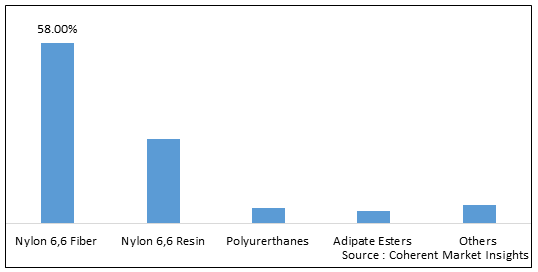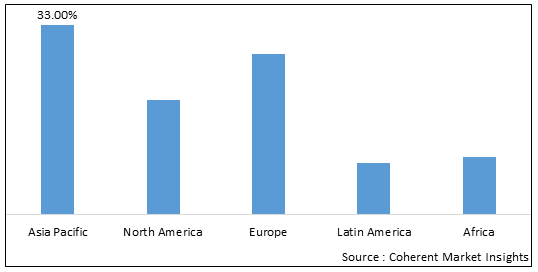
Synthetic & Bio-based Adipic Acid Market is estimated to be valued at USD 11.5 Bn in 2025 and is expected to reach USD 16.73 Bn in 2032, exhibiting a compound annual growth rate (CAGR) of 5.5% from 2025 to 2032. Adipic acid is an important raw material used in the production of industrial fiber such as Nylon 6.6. Adipic acid is basically produced by using various raw materials such as cyclohexane, benzene, and phenol. The lower purity grade of adipic acid is used to produce polyurethane whereas the high purity grade is used to produce nylon. Adipic acid is a chemical compound that appears white crystalline organic acid that contains six carbon atoms and two carboxylate groups. It is mainly used as a key raw material for the manufacturing of nylon 6.6. Automotive, medical, food, packaging & consumer goods, construction, electrical & electronics, and furniture are some of the major end-user of adipic acid.
Global Synthetic & Bio-based Adipic Acid Market
The recent outbreak of coronavirus had a negative impact on the adipic acid market because of the profitable slowdown caused by the pandemic, the use of nylon and nylon- grounded products, particularly in the machine industry, has declined significantly. As a result, demand for adipic acid in the market for the manufacture of nylon dropped. The civil lockdowns and restrictions on export- import activities have significantly impacted the global adipic acid market's supply chains and operations. On the other hand, due to the high demand for drugs during the pandemic, the use of adipic acid in the pharmaceutical industry increased. This has redounded in an increase in market demand for adipic acid.
Figure 1. Global Synthetic & Bio-based Adipic Acid Market , By Application, 2025

To learn more about this report, Download Free Sample
Global Synthetic & Bio-based Adipic Acid Market - Drivers
Growing demand for nylon from the automotive industry
Rising demand for the footwear industry
Synthetic & Bio-based Adipic Acid Market Report Coverage
| Report Coverage | Details | ||
|---|---|---|---|
| Base Year: | 2024 | Market Size in 2025: | USD 11.5 Bn |
| Historical Data for: | 2020 To 2024 | Forecast Period: | 2025 To 2032 |
| Forecast Period 2025 to 2032 CAGR: | 5.5% | 2032 Value Projection: | USD 16.73 Bn |
| Geographies covered: |
|
||
| Segments covered: |
|
||
| Companies covered: |
Invista, Rhodia, BASF, Ascend Performance Materials, Shangdong Haili (Bohui), Liaoyang Petrochemical, Asahi Kasei, Radici |
||
| Growth Drivers: |
|
||
| Restraints & Challenges: |
|
||
Uncover macros and micros vetted on 75+ parameters: Get instant access to report
Global Synthetic & Bio-based Adipic Acid Market - Restraints
Growing environmental concerns as adipic acid poses a threat to the environment as well as the health of humans are expected to restrict the market growth. Adipic acid is one of the largest sources of N2O emission and also generates non-methane volatile organic compounds. Thus, environmental concern associated with the production of adipic acid is expected to hinder market growth
Global Synthetic & Bio-based Adipic Acid Market - Segmentation
On the basis of application in 2025, the nylon 6, 6 fiber has accounted for the largest market share of 58% in terms of value, followed by nylon 6, 6 resin segment respectively. Nylon 66 is frequently used when high mechanical strength, rigidity, good stability under heat, and/or chemical resistance are required. It is used in fibers for textiles and carpets and molded parts. Typical applications for nylon 66 include interior, exterior, and under-hood automotive components, electrical and electronic components, connectors, office furniture, cutlery and cooking utensils, lawn and garden tools, fiber and filaments, and film.
Global Synthetic & Bio-based Adipic Acid Market - Opportunities
Growing demand for engineering plastic
The growing demand for engineering plastic across several end-use industries due to the advantage offered in terms of durability is expected to bring new market opportunities. They are durable, highly versatile, high-performance, and cost-effective solutions. Moreover, the expansion of the medical industry is also expected to foster the market growth of adipic acid over the forecast period.
Figure 2. Global Synthetic & Bio-based Adipic Acid Market , By Region, 2025

To learn more about this report, Download Free Sample
Increasing development of bio-based adipic acid
Increasing development of bio-based adipic acid is projected to provide enormous opportunities over the forecast period. This is attributed to growing environmental concerns and the need to promote environmental sustainability. Additionally, increasing investment by the government and manufacturers for producing bio-based adipic acid as they are cost-effective and environmentally friendly solutions to cater to various industrial applications is further anticipated to bolster market growth.
Global Synthetic & Bio-based Adipic Acid Market - Trends
Rapidly expanding packaging industry
Rapidly expanding packaging industry due to the growing trend of online shopping around the globe is expected to foster market growth. Polymers such as polyurethane produced from adipic acid are widely used in the production of packaging materials such as rigid packaging. In addition to the growing demand for packaged food due to the changing lifestyle of the consumer is again anticipated to augment the market growth of synthetic and bio-based adipic acid.
Global Synthetic & Bio-based Adipic Acid Market - Regional Insights
Asia Pacific dominated the Global Synthetic & Bio-based Adipic Acid Market in 2025 accounting for 33% in terms of value.
North America is another important market Global Synthetic & Bio-based Adipic Acid Market which has many production facilities. For instance, the U.S. is the world's leading exporter country of acetic acid.
Global Synthetic & Bio-based Adipic Acid Market - Key Developments
Global Synthetic & Bio-based Adipic Acid Market - Key Players
Major players functioning in the global synthetic & bio-based adipic acid market include Invista, Rhodia, BASF, Ascend Performance Materials, Shangdong Haili (Bohui), Liaoyang Petrochemical, Asahi Kasei, Radici.
*Definition: Adipic acid is a vital raw material used in the manufacturing of industrial fiber such as Nylon 6.6. Adipic acid is produced by using various raw materials such as benzene, cyclohexane, and phenol. The lower purity grade of adipic acid is used to produce polyurethane whereas the high purity grade is used to produce nylon. The major end-
Share
Share
About Author
Pankaj Poddar is a seasoned market research consultant with over 12 years of extensive experience in the fast-moving consumer goods (FMCG) and plastics material industries. He holds a Master’s degree in Business Administration with specialization in Marketing from Nirma University, one of India’s reputed institutions, which has equipped him with a solid foundation in strategic marketing and consumer behavior.
As a Senior Consultant at CMI for the past three years, he has been instrumental in harnessing his comprehensive understanding of market dynamics to provide our clients with actionable insights and strategic guidance. Throughout his career, He has developed a robust expertise in several key areas, including market estimation, competitive analysis, and the identification of emerging industry trends. His approach is grounded in a commitment to understanding client needs thoroughly and fostering collaborative relationships. His dedication to excellence and innovation solidifies his role as a trusted advisor in the ever-evolving landscape of not only FMCG but also chemicals and materials markets.
Missing comfort of reading report in your local language? Find your preferred language :
Transform your Strategy with Exclusive Trending Reports :
Frequently Asked Questions
Select a License Type
Joining thousands of companies around the world committed to making the Excellent Business Solutions.
View All Our Clients